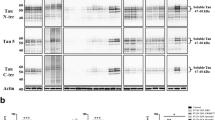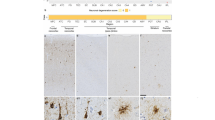Abstract
Recently, biochemical criteria were proposed to complement histological criteria for the diagnosis of dementia lacking distinctive histopathology (DLDH), the most common pathological variant of frontotemporal dementias (FTDs), based on evidence of a selective reduction of soluble tau proteins in brains from a large cohort of sporadic DLDH and hereditary FTD (HDDD2 family) patients. To ensure that these findings are not unique to the populations included in the initial report, we extended the previous work by analyzing 22 additional DLDH brains from the United States and international centers. Our biochemical analyses here confirmed the previous findings by demonstrating substantial reductions in soluble brain tau in gray and white matter of 14 cases and moderate reductions in 6 cases of DLDH. We also analyzed brain samples from an additional affected HDDD2 family member, and remarkably, unlike other previously studied members of this kindred, this patient's brain contained substantial amounts of pathological or insoluble tau. These findings confirm and extend the definition of DLDH as a sporadic or familial "tau-less" tauopathy with reduced levels of soluble brain tau and no insoluble tau or fibrillary tau inclusions, and the data also underline the phenotypic heterogeneity of HDDD2, which parallels the phenotypic heterogeneity of other hereditary neurodegenerative FTD tauopathies caused by tau gene mutations.



Similar content being viewed by others
References
Adamec E, Chang HT, Stope EG, Hedreen JC, Vonsattel JP (2001) Tau protein expression in frontotemporal dementias. Neurosci Lett 315:21–24
Arai Y, Yamazaki M, Mori O, Muramatsu H, Asano G, Katayama Y (2001) α-Synuclein-positive structures in cases with sporadic Alzheimer's disease: morphology and its relationship to tau aggregation. Brain Res 888:287–296
Arnold SE (2000) Cellular and molecular pathology of the frontal dementias. In: Clark CM, Trojanowski JQ (eds) Neurodegenerative dementias: clinical features and pathological mechanisms, McGraw-Hill, New York, pp 291–301
Arnold SE, Clark CM, Grossman M, Han LY, Trojanowski JQ (2000) Quantitative neurohistological features of frontotemporal degeneration. Neurobiol Aging 21:913–919
Bigio EH, Brown DF, White CL 3rd (1999) Progressive supranuclear palsy with dementia: cortical pathology. J Neuropathol Exp Neurol 58: 359–364
Boeve BF, Maraganore DM, Parisi JE, Ahlskog JE, Graff-Radford N, Caselli RJ, Dickson DW, Kokmen E, Petersen RC (1999) Pathologic heterogeneity in clinically diagnosed corticobasal degeneration Neurology 53: 795–800
Braak H, Braak E (1998) Argyrophilic grain disease: frequency of occurrence in different age categories and neuropathological diagnostic criteria J Neural Transm 105:801–819
Brown J, Ashworth A, Gydesen S, Sorensen A, Rossor MN, Hardy J, Collinger J (1998) Familial non-specific dementia maps to chromosome 3. Hum Mol Genet 4:1625–1628
Brun A, England B, Gustavson L, Passant U, Neary D, Snowden JS (1994) Clinical and neuropathological criteria for frontotemporal dementia. J Neurol Neurosurg Psychiatry 57:416–418
Crowther RA, Goedert M (2000) Abnormal tau-containing filaments in neurodegenerative disorders. J Struct Biol 130:271–279
D'Souza I, Schellenberg GD (2000) Determinants of 4-repeat tau expression. Coordination between enhancing and inhibitory splicing sequences for exon 10 inclusion. J Biol Chem 275:17700–17709
D'Souza I, Poorkaj P, Hong M, Nochlin D, Lee VM-Y, Bird TD, Schellenberg GD (1999) Missense and silent tau gene mutations cause frontotemporal dementia with parkinsonism-chromosome 17 type, by affecting multiple alternative RNA splicing regulatory elements. Proc Natl Acad Sci USA 96:5598–5603
Dickson DW (1998) Pick's disease: a modern approach. Brain Pathol 8:339–354
Duda JE, Giasson BI, Mabon ME, Miller DC, Golbe LI, Lee VM-Y, Trojanowski JQ (2002) Concurrence of α-synuclein and tau brain pathology in the Contursi kindred. Acta Neuropathol 104:7–11
Feany MB, Dickson DW (1996) Neurodegenerative disorders with extensive tau pathology: a comparative study and review. Ann Neurol 40:139–148
Feany MB, Mattiace LA, Dickson DW (1996) Neuropathologic overlap of progressive supranuclear palsy, Pick's disease and corticobasal degeneration. J Neuropathol Exp Neurol 55:53–67
Forman M, Zhukareva V, Bergeron C, Chin SS-M, Grossman M, Clark C, Lee VM-Y, Trojanowski JQ (2002) Signature tau neuropathology in gray and white matter of corticobasal degeneration. Am J Pathology 160:2045–2053
Forno LS, Langston JW, Herrick MK, Wilson JD, Murayama S (2002) Ubiquitin-positive neuronal and tau 2-positive glial inclusions in frontotemporal dementia of motor neuron type. Acta Neuropathol 103:599–606
Grover A, Houlden H, Baker M, Adamson J, Lewis J, Prihar G, Pickering-Brown S, Duff K, Hutton M (1999) 5' splice site mutations in tau associated with the inherited dementia FTDP-17 affect a stem-loop structure that regulates alternative splicing of exon 10. J Biol Chem 274:15134–15143
Hasegawa M, Smith MJ, Goedert M (1998) Tau proteins with FTDP-17 mutations have a reduced ability to promote microtubule assembly. FEBS Lett 437:207–210
Hong M, Zhukareva V, Vogelsberg-Ragaglia V, Wszolek Z, Reed L, Miller BL, Geschwind DH, Bird TD, McKeel D, Goate A, Morris JC, Wilhelmsen KC, Schellenberg GD, Trojanowski JQ, Lee VM-Y (1998) Mutation-specific functional impairments in distinct tau isoforms of hereditary FTDP-17. Science 282, 1914–1917
Hong M, Trojanowski JQ, Lee VM-Y (2000) Tau-based Neurofibrillary Lesions. In: Clark CM, Trojanowski JQ (eds) Neurodegenerative dementias: clinical features and pathological mechanisms. McGraw-Hill, New York, pp 161–175
Hutton M, Lendon CL, Rizzi P, et al (1998) Association of missense and 5'-splice-site mutations in tau with the inherited dementia FTDP-17. Nature 393:702–705
Jellinger KA (1998) Dementia with grains (argyrophilic grain disease). Brain Pathol 8:377–386
Knopman DS (1993) Overview of dementia lacking distinctive histology: pathological designation of a progressive dementia. Dementia 4:132–136
Knopman DS, Mastri AR, Frey WH, Sung JH, Rustan T (1990) Dementia lacking distinctive histologic features: a common non-Alzheimer's degenerative dementia. Neurology 40:251–256
Lee VM-Y, Wang J, Trojanowski JQ (1999) Purification of paired helical filament tau and normal tau from human brain tissue. Methods Enzymol 309:81–89
Lee VM-Y, Goedert M, Trojanowski JQ (2001) Neurodegenerative tauopathies. Annu Rev Neurosci 24:1121–1159
Lendon CL, Lynch T, Norton J, McKeel DW, Busfield F, Craddock N, Chakraverty S, Gopalakrishnan, Shears SD, Grimmet W, Wilhelmson KC, Hansen L, Morris JC, Goate AM (1998) Hereditary dysphasic disinhibition dementia. A frontotemporal dementia linked to 17q21-22. Neurology 50:1546–1555
Lippa C, Zhukareva V, Kawrai T, Uryu K, Shafig M, Trojanowski JQ, Lee VM-Y (2000) Frontotemporal dementia with novel tau pathology and a Glu342Val tau mutation. Ann Neurol 48:850–858
Mann DMA, Pickering-Brown S (2001) The status of "Pick's disease" and other tauopathies within the frontotemporal dementias. Neurobiol Aging 22:109–111
Morris JC, Cole M, Banker BQ, Wright D (1984) Hereditary dysphasic dementia and the Pick-Alzheimer spectrum. Ann Neurol 16:455–466
Mukaetova-Ladinska EB, Hurt J, Jakes R, Xuereb J, Honer WG, Wischik CM (2000) α-Synuclein inclusions in Alzheimer's and Lewy body diseases J Neuropathol Exp Neurol 59:408–417
Nacharaju P, Lewis J, Easson C, Yen S, Hackett J, Hutton M, Yen SH (1999) Accelerated filament formation from tau protein with specific FTDP-17 missense mutations. FEBS Lett 447:195–199
Neary D. Snowden JS, Gustavson L, Passant U, Stuss D, Black S, Freedman M, Kertesz A, Robert PH, Albert M, Boone K, Miller BL, Cummings J, Benson DF (1998) Frontotemporal lobar degeneration. A consensus on clinical diagnostic criteria. Neurology 51:546–1554
Zhukareva V, Vogelsberg-Ragaglia V, Van Deerlin VMD, Bruce J, Shuck T, Grossman M, Clark CM, Arnold S.E, Masliah E, Galasko D, Trojanowski J.Q, Lee VM-Y (2001) Loss of brain tau defines novel sporadic and familial tauopathies with frontotemporal dementia. Ann Neurol 49:165–175
Zhukareva V, Mann D, Pickering-Brown S, Uryu K, Shuck T, ShahK, Grossman M, Miller BL, Hulette CM, Feinstein SC, Trojanowski JQ, Lee VM-Y (2002) Sporadic Pick's disease: a tauopathy characterized by a spectrum of pathological tau isoforms in gray and white matter. Ann Neurol 51:730–739
Zhukareva V, Shah K, Uryu K, Braak H, Del Tredici K, Sundarraj S, Clark C, Trojanowski JQ, VM-Y. Lee (2002) Biochemical analysis of tau proteins in argyrophilic grain disease, Alzheimer's disease and Pick's disease: a comparative study. Am J Pathology 161:1135–1141
Acknowledgements
The authors thank Dr. J. Morris, Dr. V. Buckle, Dr. M. Frosch, J. Norton, MSN, RN, CS, and G. Tejada for their help in collecting tissue samples and patient information. We also thank the families of the patients, whose generosity makes this study possible. The National Institute of Aging and the Oxford Foundation (V.M.-Y.L.) provided support for this work.
Author information
Authors and Affiliations
Corresponding author
Rights and permissions
About this article
Cite this article
Zhukareva, V., Sundarraj, S., Mann, D. et al. Selective reduction of soluble Tau proteins in sporadic and familial frontotemporal dementias: an international follow-up study. Acta Neuropathol 105, 469–476 (2003). https://doi.org/10.1007/s00401-002-0668-8
Received:
Revised:
Accepted:
Published:
Issue Date:
DOI: https://doi.org/10.1007/s00401-002-0668-8




